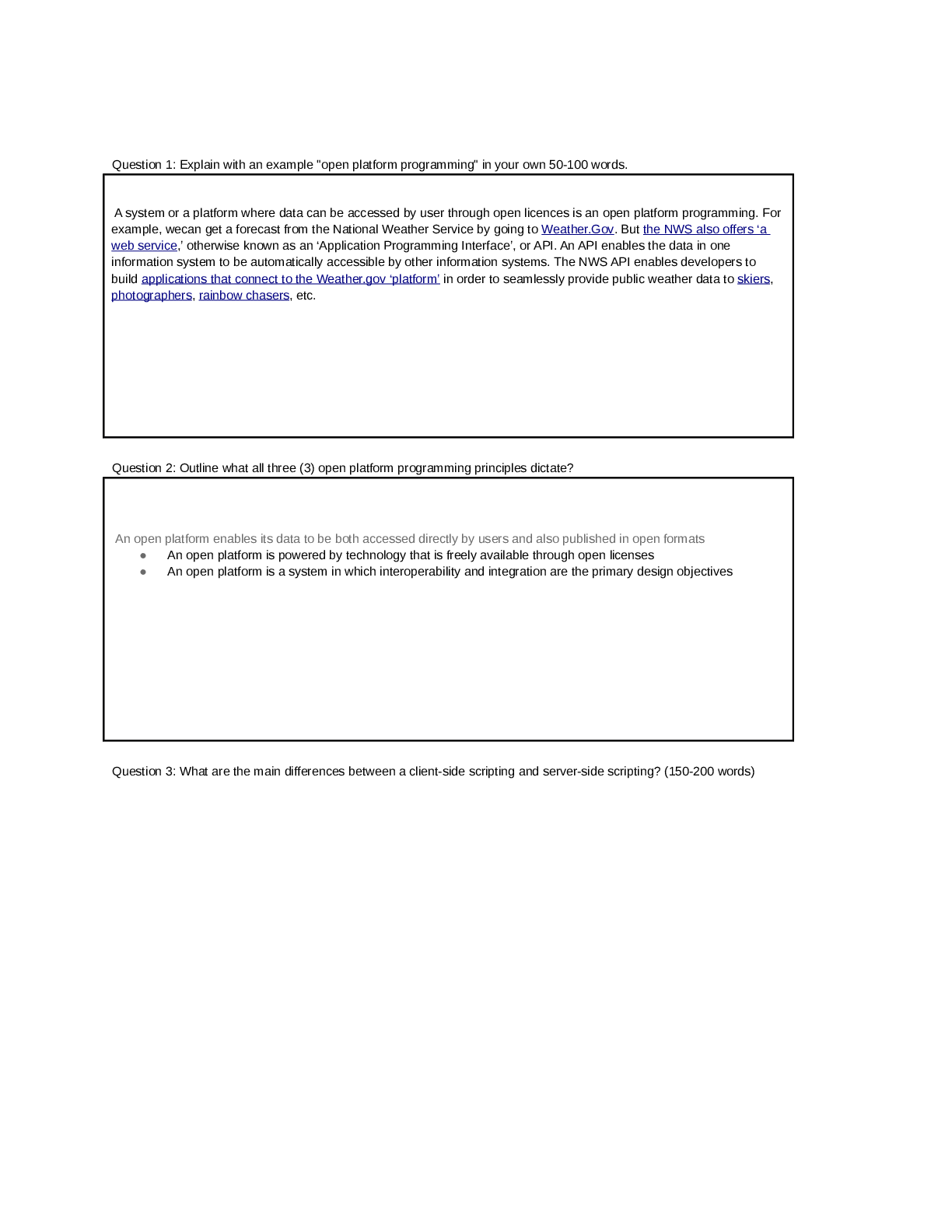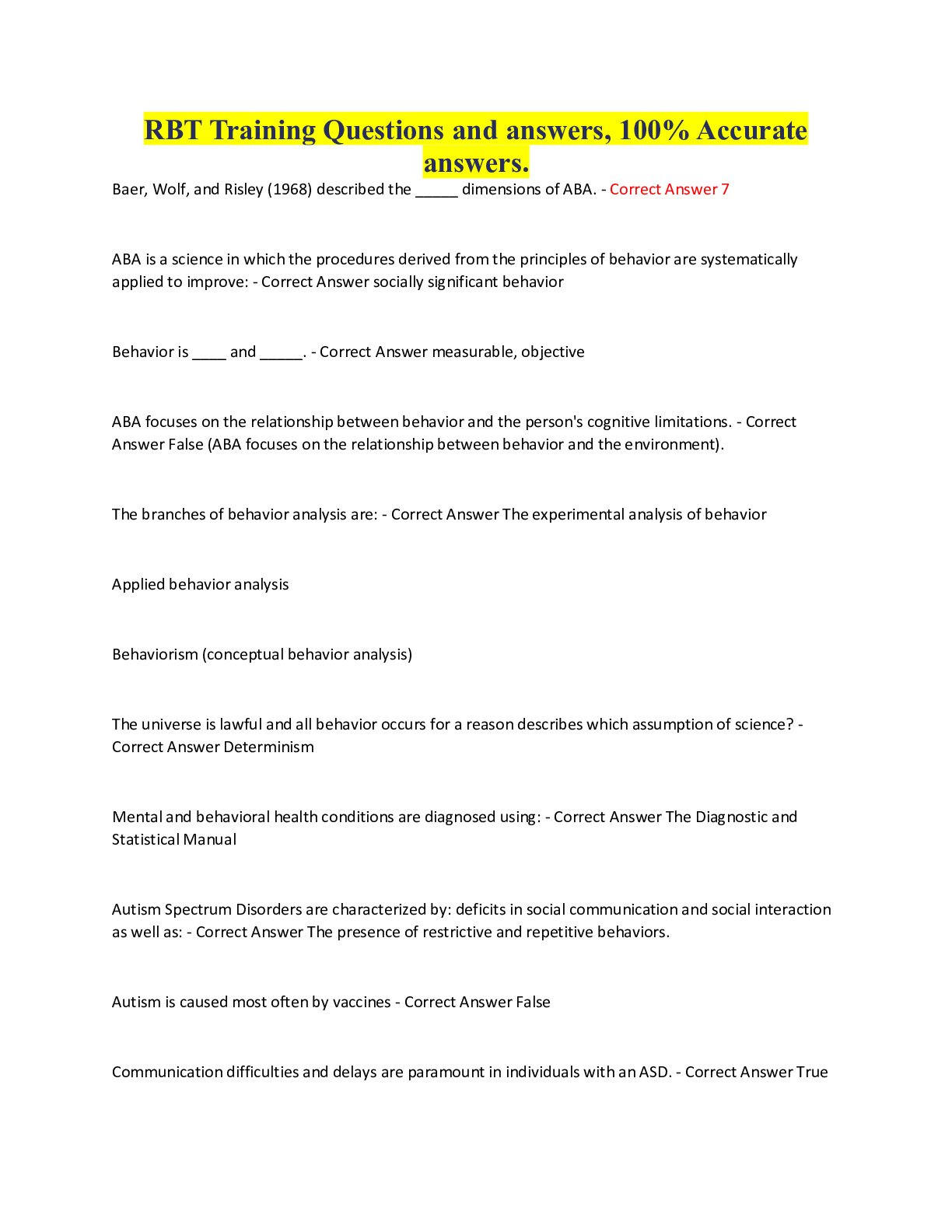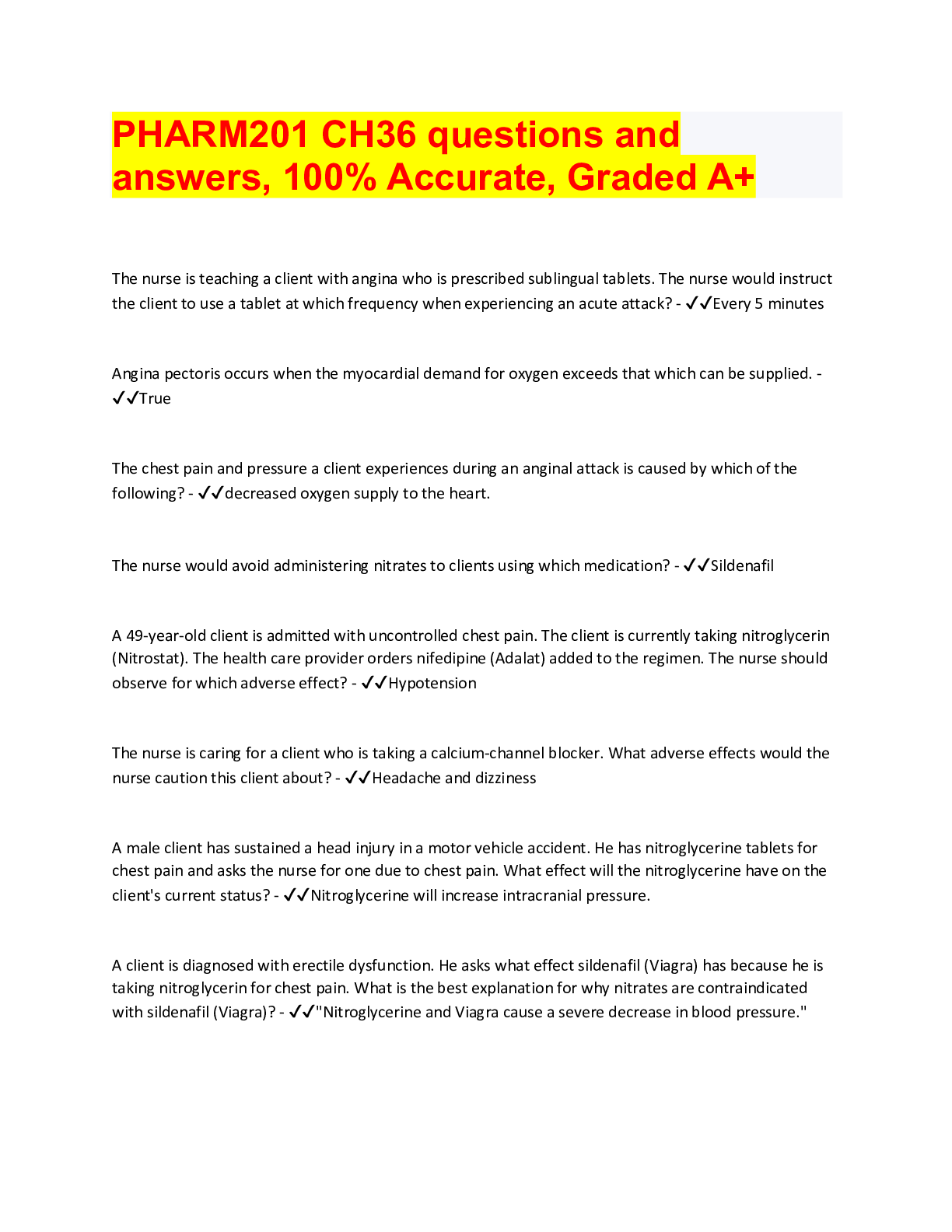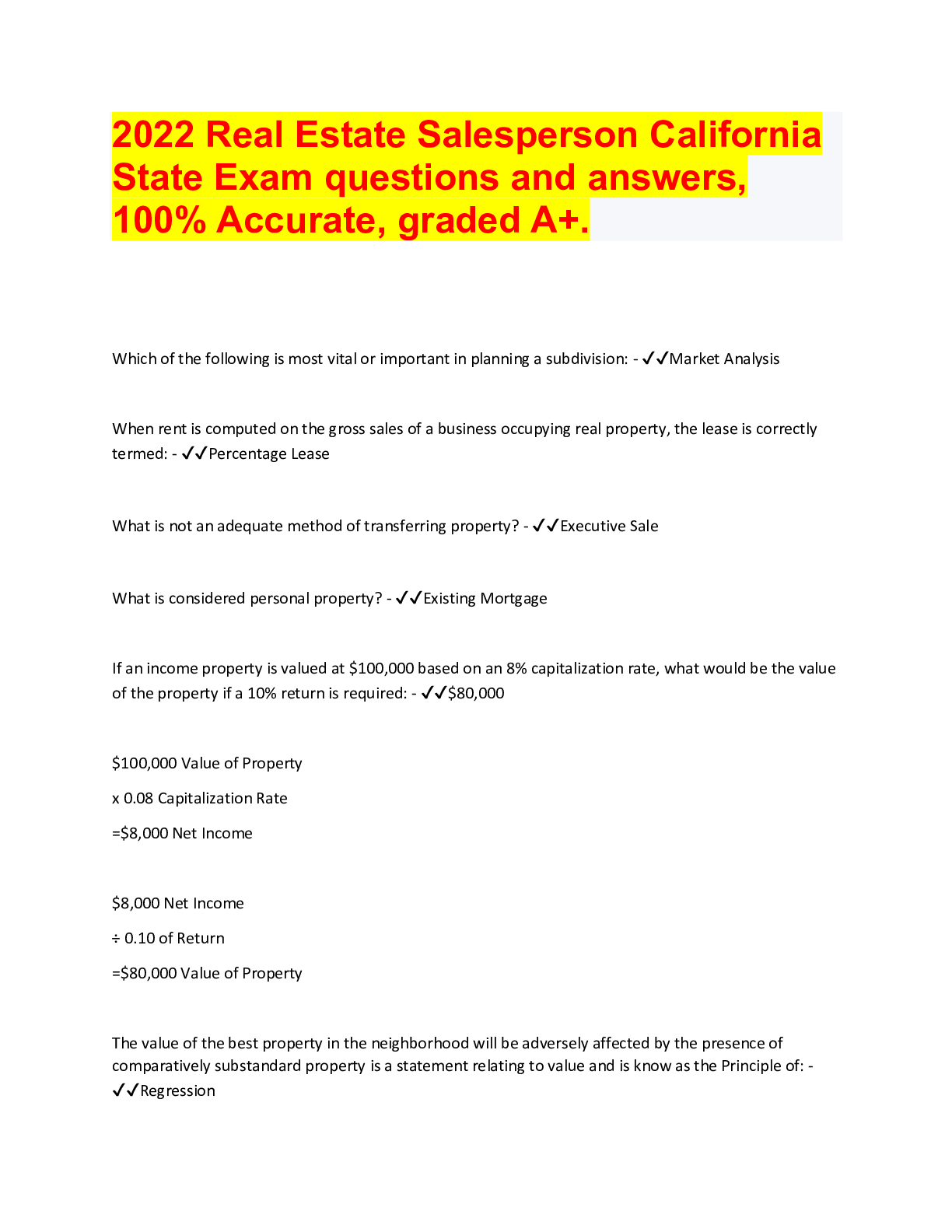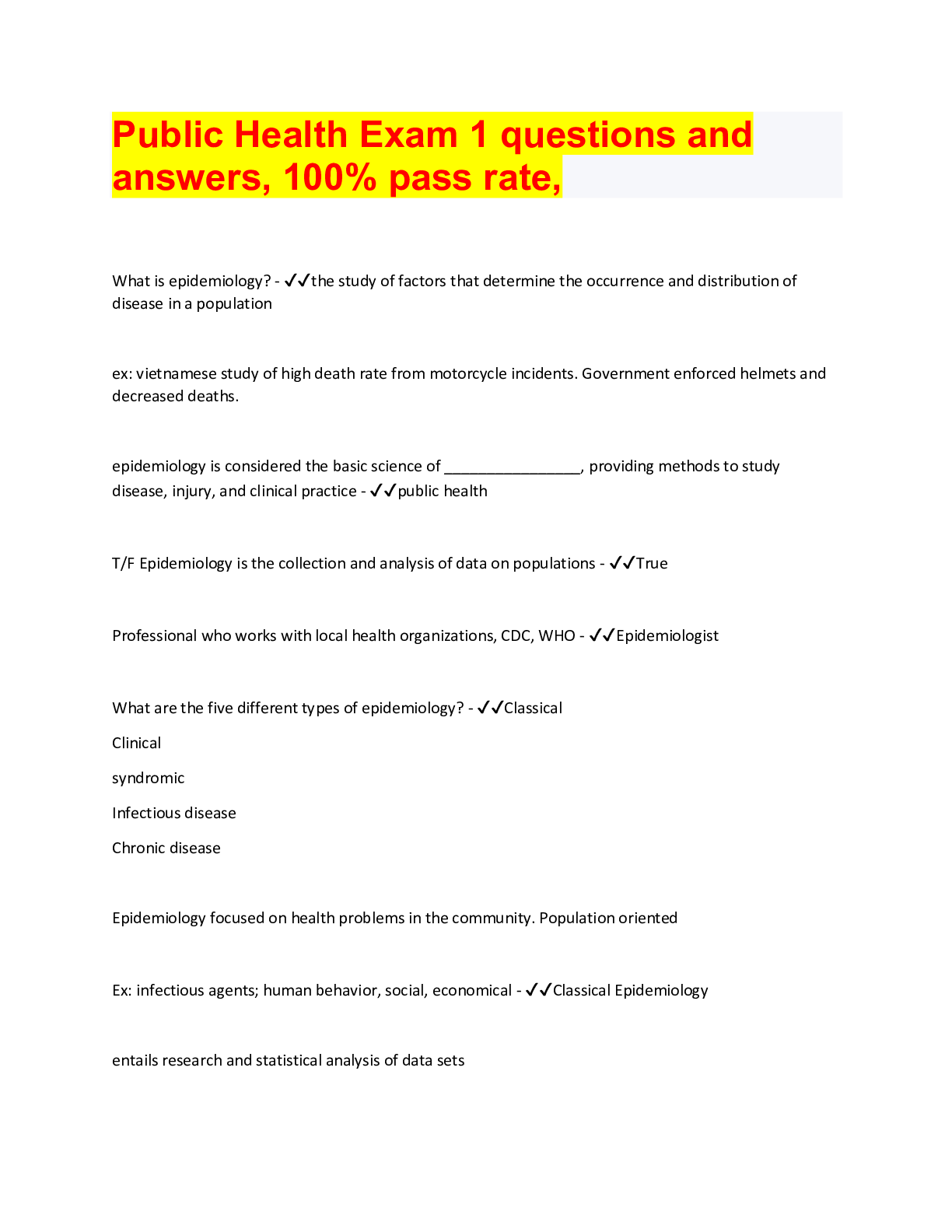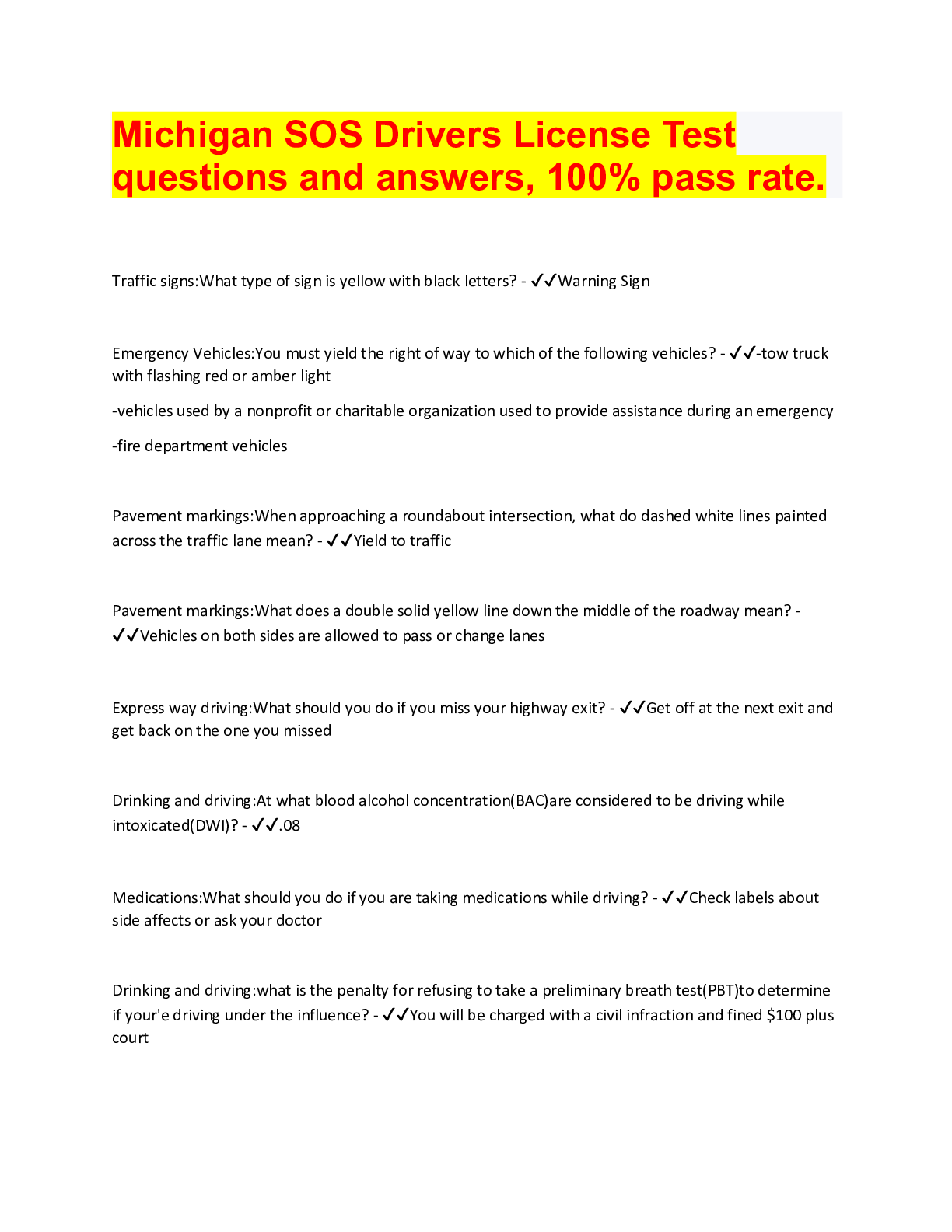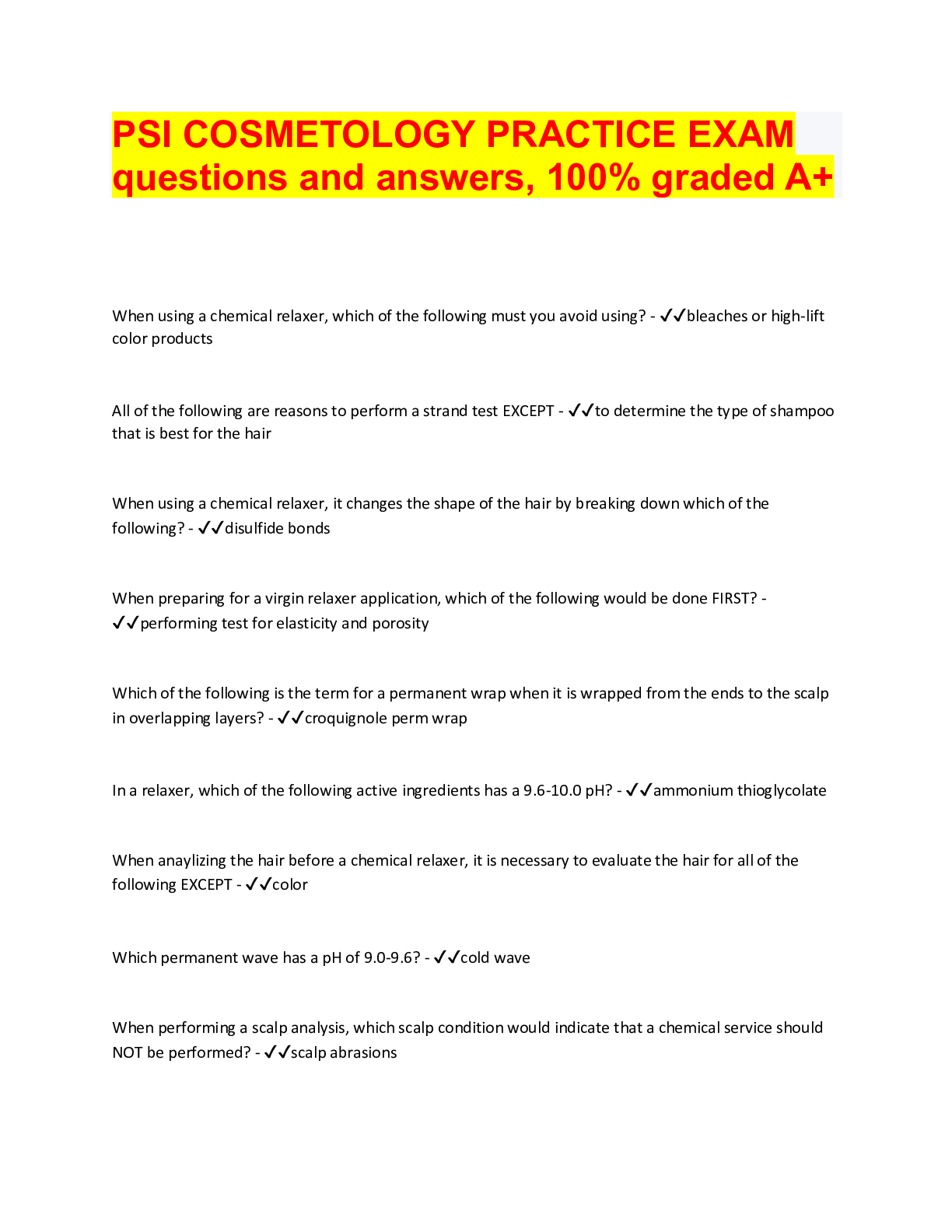*NURSING > QUESTIONS & ANSWERS > ACLS COMPLETE 2021, Exam questions and answers, 100% pass rate, (All)
ACLS COMPLETE 2021, Exam questions and answers, 100% pass rate,
Document Content and Description Below
ACLS COMPLETE 2021, Exam questions and answers, 100% pass rate, BEST PLAYLIST I'VE FOUND FOR ALL HEART.ORG ACLS CODES! - ✔✔https://www.youtube.com/watch?v=qQTpqjvvduI&list=PLy60DSDPg9urf_l... 5ss1FLakrRQDKOkTZj This is a good starting point for Jose (big Megacode at end): https://www.youtube.com/watch?v=8OB7OreUjy0 . Use the feedback after failing to get closer and closer to passing! In which situation does bradycardia require treatment? - ✔✔Hypotension Which intervention is most appropriate for the treatment of a patient in asystole? - ✔✔Epinephrine You arrive on the scene with the code team. High-quality CPR is in progress. An AED has previousy advised "no shock indicated." A rhythm check now finds asystole. After resuming high-quality compressions, which action do you take next? - ✔✔Establish IV or IO access A monitored patient in the ICU developed a sudden onset of narrow-complex tachycardia at a rate of 220/min. The patient's blood pressure is 128/58 mm Hg, the PETCO2 is 38mm Hg, and the pulse oximetry reading is 98%. There is vascular access in the left arm, and the patient has not been given any vasoactive drugs. A 12-lead ECG confirm a supraventricular tachycardia with no evidence of ischemia or infarction. The heart rate has not responded to vagal maneuvers. what is your next action? - ✔✔Administer adenosine 6mg IV push A patient has sinus bradycardia with a heart rate of 36/min. Atropine has been administered to a toal does of 3 mg. A transcutaneous pacemaker has failed to capture. The patient is confused, and her blood pressure is 88/56 mm Hg. Which therapy is now indicated? - ✔✔Epinephrine 2 to 10 mcg/min A patient is in cardiac arrest. Ventricular fibrillation has been refractory to a second shock. Which drug should be administered first? - ✔✔Epinephrine 1 mg IV/IO A 62-year-old man suddenly experienced difficulty speaking and left-sided weakness. He meets initial criteria for fibrinolytic therapy, and a CT scan of the brain si ordered. Which best describes the guidelines for antiplatelet and fibrinolytic therapy? - ✔✔Hold aspirin for at least 24 hours if rtPA is administered A patient is in refractory ventricular fibrillation and has received multiple appropriate defribillation shocks, epinephrine 1 mg IV twice, and an initial dose of amiodarone 300mg IV. The patient is intubated. Which best describe the recommended second does of amiodarone for this patient? - ✔✔150 mg IV push A patient with sinus bradycardia and a heart rate of 42/min has diaphoresis and a blood pressure of 80/60mm Hg. What is the initial does of atropine? - ✔✔0.5mg A 35-year-old woman has palpitations, light-headedness, and a stable tachycardia. The monitor shows a regular narrow-complex QRS at a rate of 180/min. Vagal maneuvers have not been effective in terminating the rhythm. An IV has been established. Which drug should be administered? - ✔✔Adenosine 6mg A patient is in cardiac arrest. Ventricular fibrillation has been refractory to an initial shock. If no pathway for medication administration is in place, which method is preferred? - ✔✔IV or IO What is the indication for the use of magnesium in cardiac arrest? - ✔✔Pulseless ventricular tachycardia-associated torsades de pointes A patient has a rapid irregular wide-complex tachycardia. The ventricular rate is 138/min. He is asymptomatic, with a blood pressure of 110/70 mm Hg. He has a history of angina. What action is recommended next? - ✔✔Seeking expert consultation A patient is in cardiac arrest. High-quality chest compressions are being given. The patient is intubated, and an IV has been started. The rhythm is asystole. What is the first drug/dose to administer? - ✔✔Epinephrine 1mg IV/IO A patient is in refractory ventricular fibrillation. High-quality CPR is in progress. One does of epinephrine was given after the second shock. An antiarrhythmic drug was given immediately after the third shock. You are the team leader. Which medication do you order next. - ✔✔Epinephrine 1 mg A patient with possible STEMI has ongoing chest discomfort. What is a contraindication to nitrate administration? - ✔✔Use of a phosphodiestrase inhibitor within the previous 24 hours A 57-year-old woman has palpitation, chest discomfort, and tachycardia. The monitor shows a regular wide-QRS at a rate of 180/min. She becomes diaphoretic, and her blood pressure is 80/60 mm HG/ Which action do you take next? - ✔✔Perform electrical cordioversion A patient with STEMI has ongoing chest discomfort. Heparin 4000 units IV bolus and a heparin infusion of 1000 units per hour are being administered. The patient did not take aspirin because he has a history of gastritis, with was treated 5 years ago. What is your next action? - ✔✔Give aspirin 160-325 mg to chew You are caring for a 66-year-old man with a history of a large intracerebral hemorrhage 2 months ago. He is being evaluated for another acute stroke. The CT scan is negative for hemorrhage. The patient is receiving oxygen via nasal cannula at 2L/min, and an IV has been established. His blood pressure is 180/100mm Hg. Which drug do you anticipate giving to this patient? - ✔✔Aspirin A patient is in pulseless ventricular tachycardia. Two shocks and 1 dose of epinephrine have been given. Which drug should be given next? - ✔✔Amiodarone 300mg What is the maximum interval for pausing chest compressions? - ✔✔10 seconds Your patient is a 56-year-old woman with a history of type 2 diabetes who reports feeling dizzy. She is pale and diaphoretic. Her blood pressure is 80/66mm Hg. The cardiac monitor documents the rhythm shown here. She is receiving oxygen at 4L/min by nasal cannula, and an Iv has been established. What do you administer next? - ✔✔Atropine 0.5mg IV A 35-year-old woman presents with a chief complaint of palpitations. She has no chest discomfort, shortness of breath, or light-headedness. Her blood pressure is 120/78mm Hg. Which intervention is indicated first? - ✔✔Vagal maneuvers Which action should you take immediately after providing an AED shock? - ✔✔Resume chest compressions What action minimizes the risk of air entering the victim's stomach during-bag mask ventilation? - ✔✔Ventilating until you see the chest rise You are providing bag-mask ventilations to a patient in respiratory arrest. How often should you provide ventilation? - ✔✔About every 5-6 seconds After initiation of CPR and 1 shock for ventricular fibrillation, this rhythm is present on the next rhythm check. A second shock is given, and chest compressions are resumed immediately. An IV is in place, and no drugs have been given. Bag-mask ventilations are producing visible chest rise. What is your next intervention? - ✔✔Give epinephrine 1mg IV/IO A patient's 12-lead ECG is transmitted by the paramedics and shows a STEMI. When the patient arrives in the emergency department, the rhythm shown here is seen on the cardiac monitor. The patient has resolution of moderate (5/10) chest pain after 3 doses of sublingual nitroglycerin. Blood pressure is 104/70mm Hg. Which intervention is most important in reducing this patient's in-hospital and 30-day mortality rate? - ✔✔Repersfusion therapy A patient was in refractory ventricular fibrillation. A thrid shock has just been administered. Your team looks to you for instructions. What is your next action? - ✔✔Resume high quality chest compressions Which action is likely to cause air to enter the victim's stomach (gastric inflation) during bag-mask ventilation? - ✔✔Ventilating too quickly A 45-year-old woman with a history of palpitations develops light-headedness and palpitations. She has received adensoine 6mg IV for the rhythm shown here (SVT), without conversion of the rhythm. She is now extremely apprehensive. Her blood pressure si 128/70mm Hg. What is the next appropriate intervention? - ✔✔Administer adenosine 12 mg IV Your patient is not responsive and is not breathing, You can palpate a carotid pulse. Which action do you take next? - ✔✔Start rescue breathing You arrive on the scene to find CPR in progress. Nursing staff report the patient was recovering from a pulmonary embolism and suddenly collapsed. Two shocks have been delivered, and an IV has been initiated. What do you administer now? - ✔✔Epinephrine 1 mg IV You are the code team leader and arrive to find a patient with CPR in progress. On the next rhythm check, you see the rhythm shown here. Team members tell you that the patient was well but reported chest discomfort and then collapsed. She has no pulse or respirations. Bag-mask ventilations are producing visible chest rise, and IV access has been established, Which intervention would be your next action? - ✔✔Epinephrine 1mg What is recommended depth of chest compressions for an adult victim? - ✔✔At least 2 inches How does complete chest recoil contribute to effective CPR? - ✔✔Allows maximum blood return to the heart What is the recommended compression rate for high-quality CPR? - ✔✔100-120 compressions per minute A patient becomes unresponsive. You are uncertain if a faint pulse is present. They rhythm shown here is seen on the cardiac monitor. An IV is in pace. Which action do you take next? - ✔✔Start high-quality CPR A patient has been resuscitated from cardiac arrest. During post-ROSC treatment, the patient becomes unresponsive, with the rhythm shown here. Which action is indicated next? - ✔✔Give an immediate unsynchronized high-energy shock (defibrillation dose) How often should you switch chest compressors to avoid fatigue? - ✔✔About every 2 minutes You find an unresponsive pt. who is not breathing. After activating the emergency response system, you determine there is no pulse. What is your next action? - ✔✔Start chest compressions of at least 100 per min. You are evaluating a 58-year-old man with chest pain. The blood pressure is 92/50 mm Hg, the heart rate is 92/min, the nonlabored respiratory rate is 14 breaths/min, and the pulse oximetry reading is 97%. What assessment step is most important now? - ✔✔Obtaining a 12 lead ECG. What is the preferred method of access for epi administration during cardiac arrest in most pts? - ✔✔Peripheral IV An AED does not promptly analyze a rythm. What is your next step? - ✔✔Begin chest compressions. You have completed 2 minutes of CPR. The ECG monitor displays the lead II rhythm below, and the patient has no pulse. Another member of your team resumes chest compressions, and an IV is in place. What management step is your next priority? - ✔✔Administer 1mg of epinephrine During a pause in CPR, you see this lead II ECG rhythm on the monitor. The patient has no pulse. What is the next action? - ✔✔Resume compressions What is a common but sometimes fatal mistake in cardiac arrest management? - ✔✔Prolonged interruptions in chest compressions. Which action is a componant of high-quality chest comressions? - ✔✔Allowing complete chest recoil Which action increases the chance of successful conversion of ventricular fibrillation? - ✔✔Providing quality compressions immediately before a defibrillation attempt. Which situation BEST describes pulseless electrical activity? - ✔✔Sinus rythm without a pulse What is the BEST strategy for performing high-quality CPR on a patient with an advanced airway in place? - ✔✔Provide continuous chest compressions without pauses and 10 ventilations per minute. Three minutes after witnessing a cardiac arrest, one member of your team inserts an endotracheal tube while another performs continuous chest compressions. During subsequent ventilation, you notice the presence of a waveform on the capnography screen and a PETCO2 level of 8 mm Hg. What is the significance of this finding? - ✔✔Chest compressions may not be effective. The use of quantitative capnography in intubated patients - ✔✔allows for monitoring of CPR quality. For the past 25 minutes, an EMS crew has attempted resuscitation of a patient who originally presented in ventricular fibrillation. After the first shock, the ECG screen displayed asystole, which has persisted despite 2 doses of epinephrine, a fluid bolus, and high-quality CPR. What is your next treatment? - ✔✔Consider terminating resuscitive efforts after consulting medical control. Which is a safe and effective practice within the defibrillation sequence? - ✔✔Be sure oxygen is not blowing over the patient's chest during the shock. During your assessment, your patient suddenly loses consciousness. After calling for help and determining that the patient is not breathing, you are unsure whether the patient has a pulse. What is your next action? - ✔✔Begin chest compressions. What is an advantage of using hands-free defibrillation pads instead of defibrillation paddles? - ✔✔Hands-free pads allow for a more rapid defibrillation. What action is recommended to help minimize interruptions in chest compressions during CPR? - ✔✔Continue CPR while charging the defibrillator. Which action is included in the BLS survey? - ✔✔Early defibrillation Which drug and dose are recommended for the management of a patient in refractory ventricular fibrillation? - ✔✔Amioderone 300mg What is the appropriate interval for an interruption in chest compressions? - ✔✔10 seconds or less Which of the following is a sign of effective CPR? - ✔✔PETCO2 ≥10 mm Hg What is the primary purpose of a medical emergency team (MET) or rapid response team (RRT)? - ✔✔Identifying and treating early clinical deterioration. Which action improves the quality of chest compressions delivered during a resuscitation attempt? - ✔✔Switch providers about every 2 minutes or every 5 compression cycles. What is the appropriate ventilation strategy for an adult in respiratory arrest with a pulse rate of 80/min? - ✔✔1 breath every 5-6 seconds A patient presents to the emergency department with new onset of dizziness and fatigue. On examination, the patient's heart rate is 35/min, the blood pressure is 70/50 mm Hg, the respiratory rate is 22 breaths/min, and the oxygen saturation is 95%. What is the appropriate first medication? - ✔✔Atropine 0.5mg A patient with dizziness and shortness of breath with a sinus bradycardia of 40/min. The initial atropine dose was ineffective, and your monitor/defibrillator is not equipped with a transcutaneous pacemaker. What is the appropriate dose of dopamine for this patient? - ✔✔2 to 10 mcg/kg per minute A patient has sudden onset of dizziness. The patient's heart rate is 180/min, blood pressure is 110/70 mm Hg, respiratory rate is 18 breaths/min, and pulse oximetry reading is 98% on room air. The lead II ECG is shown below: - ✔✔Vagal manuever. A monitored patient in the ICU developed a sudden onset of narrow-complex tachycardia at a rate of 220/min. The patient's blood pressure is 128/58 mm Hg, the PETCO2 is 38 mm Hg, and the pulse oximetry reading is 98%. There is vascular access at the left internal jugular vein, and the patient has not been given any vasoactive drugs. A 12-lead ECG confirms a supraventricular tachycardia with no evidence of ischemia or infarction. The heart rate has not responded to vagal maneuvers. What is the next recommended intervention? - ✔✔Adenosine 6mg IV push You are receiving a radio report from an EMS team en route with a patient who may be having an acute stroke. The hospital CT scanner is not working at this time. What should you do in this situation? - ✔✔Divert the patient to a hospital 15 minutes away with CT capabilities. Choose an appropriate indication to stop or withhold resuscitative efforts. - ✔✔Evidence of rigor mortis. A 49-year-old woman arrives in the emergency department with persistent epigastric pain. She had been taking oral antacids for the past 6 hours because she thought she had heartburn. The initial blood pressure is 118/72 mm Hg, the heart rate is 92/min and regular, the nonlabored respiratory rate is 14 breaths/min, and the pulse oximetry reading is 96%. Which is the most appropriate intervention to perform next? - ✔✔Obtain a 12 lead ECG. A patient in respiratory failure becomes apneic but continues to have a strong pulse. The heart rate is dropping rapidly and now shows a sinus bradycardia at a rate of 30/min. What intervention has the highest priority? - ✔✔Simple airway manuevers and assisted ventilations. What is the appropriate procedure for endotracheal tube suctioning after the appropriate catheter is selected? - ✔✔Suction during withdrawal but for no longer than 10 seconds. While treating a patient with dizziness, a blood pressure of 68/30 mm Hg, and cool, clammy skin, you see this lead II ECG rhythm:What is the first intervention ? - ✔✔Atropine 0.5mg A 68-year-old woman experienced a sudden onset of right arm weakness. EMS personnel measure a blood pressure of 140/90 mm Hg, a heart rate of 78/min, a nonlabored respiratory rate of 14 breaths/min, and a pulse oximetry reading of 97%. The lead II ECG displays sinus rhythm. What is the most appropriate action for the EMS team to perform next? - ✔✔Cincinnati Prehospital Stroke Scale assessment EMS is transporting a patient with a positive prehospital stroke assessment. Upon arrival in the emergency department, the initial blood pressure is 138/78 mm Hg, the pulse rate is 80/min, the respiratory rate is 12 breaths/min, and the pulse oximetry reading is 95% on room air. The lead II ECG displays sinus rhythm. The blood glucose level is within normal limits. What intervention should you perform next? - ✔✔Head CT scan What is the proper ventilation rate for a patient in cardiac arrest who has an advanced airway in place? - ✔✔8-10 breaths per minute A 62-year-old man in the emergency department says that his heart is beating fast. He says he has no chest pain or shortness of breath. The blood pressure is 142/98 mm Hg, the pulse is 200/min, the respiratory rate is 14 breaths/min, and pulse oximetry is 95% on room air. What intervention should you perform next? - ✔✔Obtain a 12 lead ECG. You are evaluating a 48-year-old man with crushing substernal chest pain. The patient is pale, diaphoretic, cool to the touch, and slow to respond to your questions. The blood pressure is 58/32 mm Hg, the heart rate is 190/min, the respiratory rate is 18 breaths/min, and the pulse oximeter is unable to obtain a reading because there is no radial pulse. The lead II ECG displays a regular wide-complex tachycardia. What intervention should you perform next? - ✔✔Synchronized cardioversion What is the initial priority for an unconscious patient with any tachycardia on the monitor? - ✔✔Determine whether pulses are present. Which rhythm requires synchronized cardioversion? - ✔✔Unstable supraventricular tachycardia What is the recommended second dose of adenosine for patients in refractory but stable narrow-complex tachycardia? - ✔✔12mg What is the usual post-cardiac arrest target range for PETCO2 when ventilating a patient who achieves return of spontaneous circulation (ROSC)? - ✔✔35-40mm Hg Which condition is a contraindication to therapeutic hypothermia during the post-cardiac arrest period for patients who achieve return of spontaneous circulation ROSC? - ✔✔Responding to verbal commands What is the potential danger of using ties that pass circumferentially around the patient's neck when securing an advanced airway? - ✔✔Obstruction of venous return from the brain What is the most reliable method of confirming and monitoring correct placement of an endotracheal tube? - ✔✔Continuous waveform capnography hat is the recommended IV fluid (normal saline or Ringer's lactate) bolus dose for a patient who achieves ROSC but is hypotensive during the post-cardiac arrest period? - ✔✔1 to 2 Liters What is the minimum systolic blood pressure one should attempt to achieve with fluid, inotropic, or vasopressor administration in a hypotensive post-cardiac arrest patient who achieves ROSC? - ✔✔90mm Hg What is the first treatment priority for a patient who achieves ROSC? - ✔✔Optimizing ventilation and oxygenation. What should be done to minimize interruptions in chest compressions during CPR? - ✔✔Continue CPR while the defibrillator is charging. Which condition is an indication to stop or withhold resuscitative efforts? - ✔✔Safety threat to providers After verifying the absence of a pulse, you initiate CPR with adequate bag-mask ventilation. The patient's lead II ECG appears below. What is your next action? - ✔✔IV or IO access After verifying unresponsiveness and abnormal breathing, you activate the emergency response team. What is your next action? - ✔✔Check for a pulse. What is the recommendation on the use of cricoid pressure to prevent aspiration during cardiac arrest? - ✔✔Not recommended for routine use What survival advantages does CPR provide to a patient in ventricular fibrillation? - ✔✔Produces a small amount of blood flow to the heart What is the recommended compression rate for performing CPR? - ✔✔At least 100 per minute EMS personnel arrive to find a patient in cardiac arrest. Bystanders are performing CPR. After attaching a cardiac monitor, the responder observes the following rhythm strip. What is the most important early intervention? - ✔✔defibrillation A patient remains in ventricular fibrillation despite 1 shock and 2 minutes of continuous CPR. The next intervention is to - ✔✔administer a second shock. What is the recommended next step after a defibrillation attempt? - ✔✔Begin CPR, starting with chest compressions. Which of the following is the recommended first choice for establishing intravenous access during the attempted resuscitation of a patient in cardiac arrest? - ✔✔Antecubital vein [Show More]
Last updated: 1 year ago
Preview 1 out of 40 pages
Instant download

Buy this document to get the full access instantly
Instant Download Access after purchase
Add to cartInstant download
Also available in bundle (1)
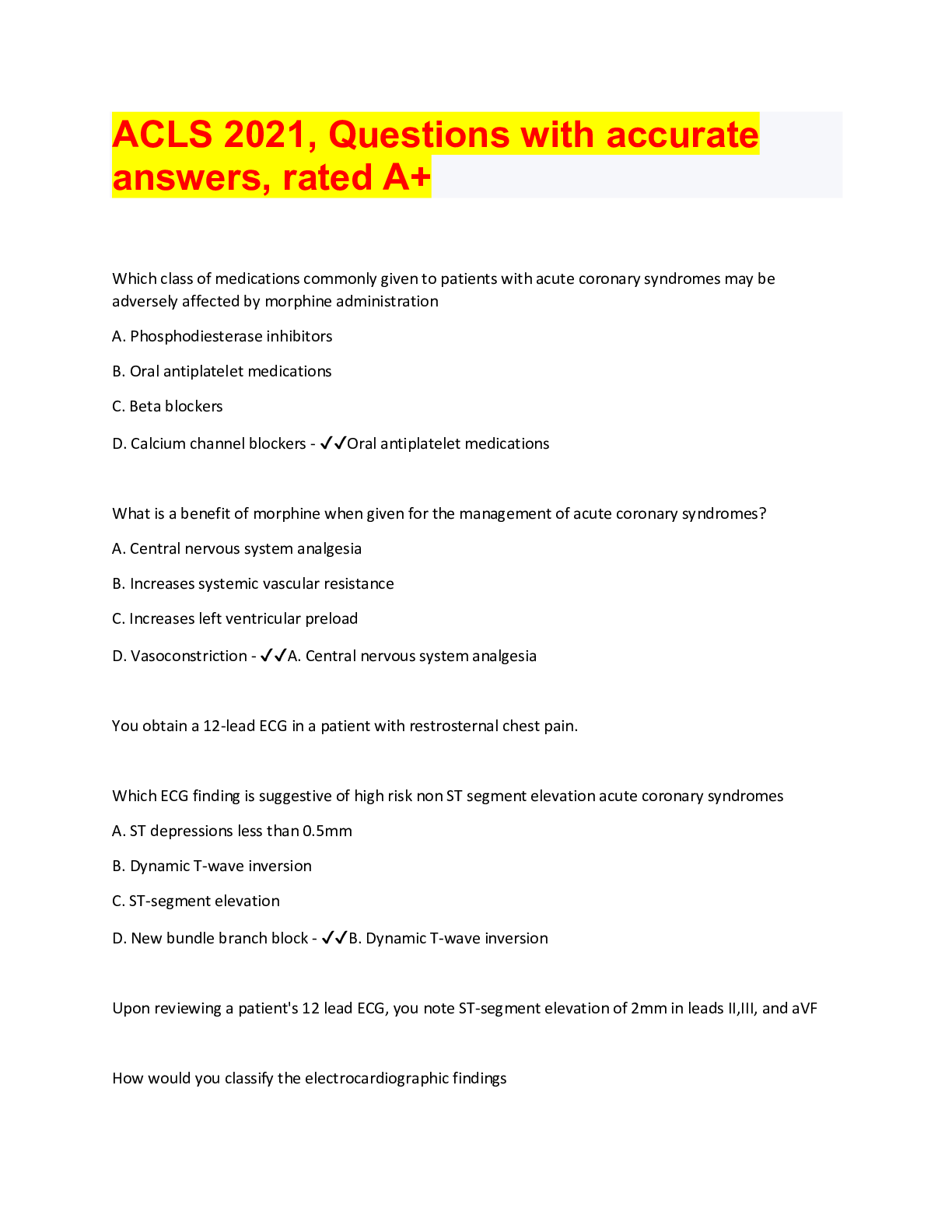
ACLS EXAM BUNDLE
Questions and answers, masterpieces, predictor papers, download to score
By bundleHub Solution guider 1 year ago
$38
10
Reviews( 0 )
Document information
Connected school, study & course
About the document
Uploaded On
Aug 21, 2022
Number of pages
40
Written in
Additional information
This document has been written for:
Uploaded
Aug 21, 2022
Downloads
0
Views
162













